The Spanish Missions of San Antonio, Texas
About the Missions of San Antonio:
A chain of five missions established along the San Antonio River in the 18th century became the largest concentration of Catholic missions in North America. Built primarily to expand Spanish New World influence north from Mexico, the missions also served to introduce native inhabitants to Catholicism and Spanish society.
On May 1, 1718, the Spanish established a mission-presidio complex approximately midway between the Rio Grande Valley and the missions of East Texas. This was the founding of the city of San Antonio, the most significant Texas settlement of the Spanish era. Probably the most well known, Mission San Antonio de Valero (later to be known as the Alamo) was earlier established south on the Rio Grande River near the town of Guerrero, Mexico, before being moved here.
In 1720, a second mission, San Jose y San Miguel de Aguayo, was established downstream on the San Antonio River.
Three of the missions (Concepcion, Espada, and San Juan Capistrano) were originally founded in East Texas. As the East Texas missions succumbed to drought, malaria and French incursions, they were relocated to the central part of Texas here in San Antonio.
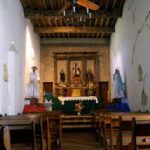
Through an agreement with the Archdiocese of San Antonio, the San Antonio Missions National Historical Park of the National Park Service administers and oversees these missions today. All of them, with the exception of the Alamo, are operating Catholic parishes with regular Sunday Masses, weddings, baptisms and other parish events.
Admission to all the missions is free.
Note that we are highlighting the churches at each mission, but the actual missions covered several acres protected by walls. This helped protect the natives as well as the Spanish explorers. The church was central to the daily life in the Missions.
The Alamo (1718)
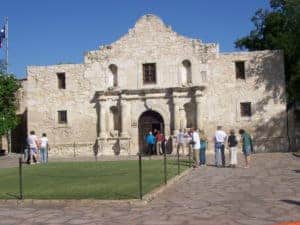 Perhaps the most recognizable symbol in Texas, the Alamo was established as a mission in 1718. The building you see today is the chapel—-all that is left of the original fort except for the barracks and walls surrounding the mission. It is here in 1836 that 189 defenders held the site against 4,000 Mexican troops for 13 days before being overrun and killed to the last man. The defeat here galvanized the “Texian” forces and led to independence for Texas. The building is a shrine, so talking and photography are forbidden inside the chapel.
Perhaps the most recognizable symbol in Texas, the Alamo was established as a mission in 1718. The building you see today is the chapel—-all that is left of the original fort except for the barracks and walls surrounding the mission. It is here in 1836 that 189 defenders held the site against 4,000 Mexican troops for 13 days before being overrun and killed to the last man. The defeat here galvanized the “Texian” forces and led to independence for Texas. The building is a shrine, so talking and photography are forbidden inside the chapel.
The museum and library are near the chapel and contain relics and mementos from the Republic of Texas and offers a narration on the fall of the Alamo. Hours are 9 a.m. to 5:30 p.m. Monday-Saturday and 10 a.m.-5:30 p.m. on Sundays.
Address: 300 Alamo Plaza, San Antonio, TX 78205
The Four Missions of San Antonio:
Mission Concepcion (1731)
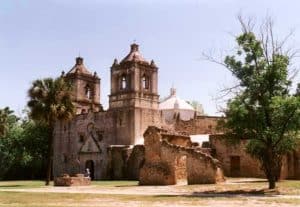
One of the most attractive of the San Antonio missions, Concepcion was named after Our Lady of the Immaculate Conception and looks essentially as it did 200 years ago. The mission was well known for its religious celebrations. Over time the beautiful designs on the exterior have disappeared; however, inside are original paintings of religious symbols and architectural designs. Historical exhibits lead visitors around the grounds and through various rooms. The site also features a visitor contact station and a gift shop.
A phenomenon occurs every year on August 15 (The Feast of the Assumption of Mary) when, at 6:30 p.m, the small windows in the rear of the church allow two beams of light to illuminate the Virgin Mary’s face and altar floor.
A little-known fact is that the Texas revolution actually began here in 1835, at what became known as the Battle of Concepcion, when a group of Texians led by Jim Bowie fought Mexican forces for the first time. Bowie, of course, was later killed at the Battle of the Alamo.
Address: 807 Mission Road, San Antonio, TX 78210
Mission San Jose (1720)
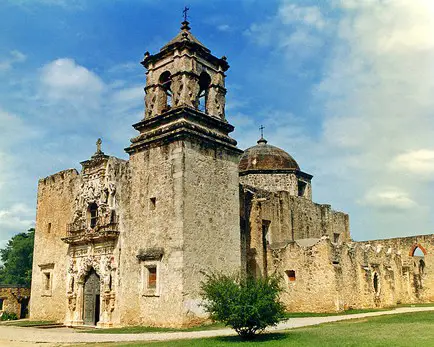
Known as the “Queen of the Missions”, it is the largest of the missions and was a major social and cultural center. Among the San Antonio missions, it provided the strongest garrison against raids from Indians.
The carvings on the church are notable features: carved above the main door are St. Dominic, St. Joseph with Jesus, and St. Francis.
The statues surrounding the door are St. Joachim, Our Lady of Guadalupe, and St. Anne with child Mary and the famous “Rose Window” is considered one of the finest pieces of Spanish Colonial ornamentation in North America.
Located on the South wall of the Church sacristy, it has been described as the site where the Host was shown to the Mass celebrants during the Feast of Pentecost. Other features are the Convento area and the stairway to the belfry and choir loft—each of the 25 risers was hand-hewn from a single live-oak log and constructed without nails or pegs. Also featured is a granary with flying buttresses, a gristmill, restored defensive walls and quarters. It also contains a visitor information center.
Address: 6701 San Jose Drive, San Antonio, TX 78214
Mission Espada (1731)
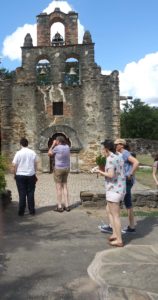 Originally named San Francisco de los Tejas, Espada was renamed and relocated to San Antonio in 1731. It is the southernmost of the chain of missions located on the San Antonio River. Mission Espada features a very attractive chapel, along with an unusual door and stone entrance archway.
Originally named San Francisco de los Tejas, Espada was renamed and relocated to San Antonio in 1731. It is the southernmost of the chain of missions located on the San Antonio River. Mission Espada features a very attractive chapel, along with an unusual door and stone entrance archway.
Be sure to view the Espada Acequia: in order to carry water to the fields for the missions around San Antonio, the Franciscans developed an elaborate irrigation system: an aqueduct to bring water to the mission. The system irrigated approximately 3,500 acres of land.
Address: 10040Espada Road, San Antonio, Texas 78214
Mission San Juan (1731)
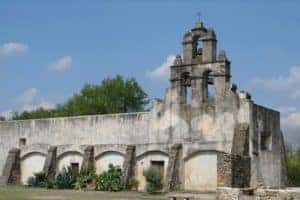
San Juan Capistrano made its permanent home on the banks of the San Antonio River in 1731 after relocating from East Texas. Within a short time, the mission became a regional supplier of agricultural and other products including iron, wood, cloth, and leather goods produced by the Indians in its workshops. A few miles south of the mission was Rancho Pataguilla, which in 1762 reported 3,500 sheep and nearly as many cattle.
The mission is the smallest of the four, holding about 80 worshipers in the pews with room for another standing. The chapel, with its open bell tower, is still in use. The site includes a self-guided nature trail. The mission has undergone remodeling in 2012 to restore it to its original look.
Address: 9101 Graf Road. San Antonio, Texas 78214
Traveling to the Missions of San Antonio:
The Missions are all within a short drive of one another. The Alamo is directly downtown while the others are just a few miles from the Alamo. The other four missions are only about one mile apart from each other. There is also a trolley that will take you to the missions from Alamo Plaza. There is an information center there that also has free maps.
Cell phone tour: you can now take a free cell-phone tour while visiting the missions (or from anywhere). Just call 1-210-852-2407. You will be charged for your cell phone usage according to your plan.
Click here for the Archdiocese site devoted to the Missions
Click here for the National Park Service website for further information. (check out their photo section).
Here is an interesting read about the San Antonio Missions from Southern Living magazine.
⇐ Back to Catholic places of interest in San Antonio, Texas

